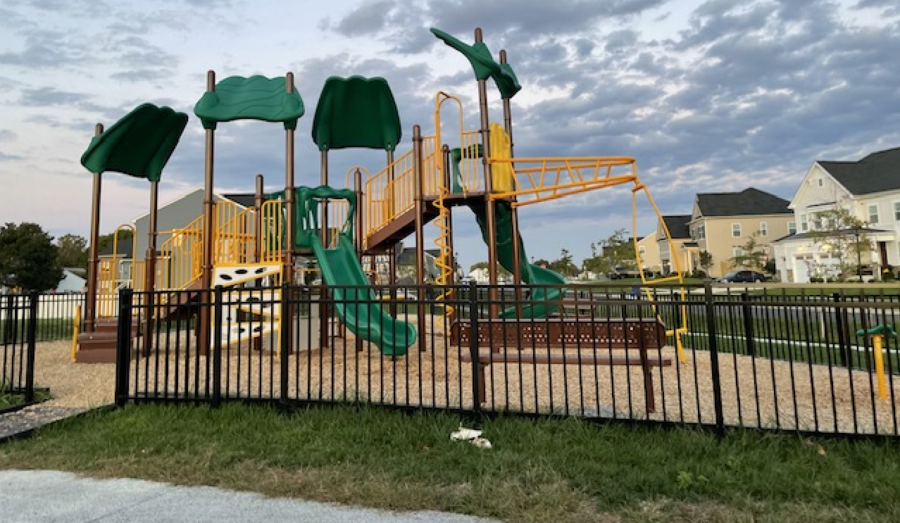A playground is a wonderful place for kids to play, exercise, build skills, and make friends. It’s important that the materials used in playgrounds are as safe as possible.
Playground surfacing is used under play equipment to protect children from fall injuries. Surfacing options are grouped into two broad categories: unitary and loose-fill. Unitary surfacing is a smooth surface — for example, pour-in-place (PIP) and rubber tiles are made with rubber or cork granules held together by a binder. Loose-fill surfacing is what it sounds like: loose particles such as pieces of wood, pieces of rubber, pea gravel, or sand. Depending on the materials used to make either loose-fill or unitary surfacing, these options are variable in terms of fall protection, accessibility, and chemical hazards.
Pour-in-place rubber surfacing
PIP unitary surfacing draws its name from the way it is installed. The top layer of PIP – composed of rubber granules often in bright colors and patterns, and held together by a binder – is mixed and poured into the playground on site by workers. Just below that top layer is a cushioning layer, usually made from shredded waste tires. As the top layer breaks down over time, the loose tire shreds underneath can be exposed.
While PIP rubber surfacing can be aesthetically pleasing when new, PIP surfaces can contribute to rubber and plastic pollution in the environment. If you look closely at the soil around a pour-in-place playground, you may see small bits of rubber that escape from the product as it wears.
There are also concerns about chemical hazards. In 2019, the Ecology Center tested several playgrounds in Washington, DC and found high levels of lead contamination on some of the PIP surfaces (see this blog to learn more about the Ecology Center’s work on play surfacing). A recent study found organophosphate esters, used as flame retardants and plasticizers, in several PIP materials.
Rubber PIP surfacing can also get very hot. For example, as noted in our recently updated report on playground surfacing, on a day when the air temperature measured 75 degrees F, a parents’ group documented a temperature over 170 degrees F on a PIP playground surface.
Waste tire mulch
Some playgrounds are surfaced with loose shredded tire mulch, also known as rubber mulch. These pose a particular concern as children are directly exposed to the waste tire material in loose form, and can readily handle and play with the material. Waste tires contain a variety of chemicals of concern, including lead, polyaromatic hydrocarbons (PAHs), vulcanization compounds such as benzothiazole, and antiozonants such as 6PPD.
Some communities and schools that have previously installed shredded tire mulch surfacing are now revisiting that decision. For example, the community of Poolesville, in Montgomery County, MD previously had loose fill surfacing made from shredded waste tires in seven town playgrounds. In 2022, a small fire was set in one of the playgrounds. The shredded tires ignited, creating a large plume of smoke. In 2023, the community revisited its decision to use waste tires in play areas. The Poolesville commissioners reviewed new evidence on health and environmental concerns related to the use of these materials, and opted to replace the waste tires with engineered wood fiber (EWF) in all the playgrounds.
Safer alternatives
Alternatives to rubber-based products include wood chips, bark mulch, engineered wood fiber (EWF), pea gravel, or sand. Pea gravel and sand provide less fall protection, but can be a reasonable choice in some settings where play structures are lower, or there is primarily ground play. Wood chips and EWF, on the other hand, both provide high fall protection. EWF has the additional advantage of providing accessibility.
Loose-fill wood chips, bark mulch, and EWF are all made from raw wood. Wood chips are made from ground fresh trees, and bark mulch is a byproduct of the industrial paper and lumber industries. EWF is a finely shredded wood mulch that is designed specifically for use as playground safety surface material. Wood products can only be labeled EWF if they meet the specific particle size, consistency, purity, and drainage standards described in American Society for Testing and Materials (ASTM) 2075: Standard specification for engineered wood fiber. EWF is also tested for levels of soluble hazardous elements such as lead, chromium, cadmium, and arsenic.
Wood products designed for use in playgrounds are a safer alternative to waste tires or other synthetic materials on the market, as long as they are tested to verify the absence of chromated copper arsenate (CCA). CCA is a highly toxic pesticide that was used in the past in pressure-treated wood. Look for wood products labeled for playground use. Although the products are made from raw wood, it is essential to ask the vendor for CCA testing data to rule out contamination.
For communities that wish to install a unitary playing surface while avoiding the hazards of the rubber-based materials, a cork-based PIP product may be an option. These products are more expensive per square foot than others.
Fall protection
The Consumer Product Safety Commission (CPSC) requires that playground surfacing materials be tested for critical height, which is “an approximation of the fall height below which a life-threatening head injury would not be expected to occur.” The CPSC recommends testing the impact performance of playground materials annually. Communities can ask their chosen playground installation company about annual field tests for impact performance. Communities may also choose to install play equipment that requires lower fall height protection.
EWF, wood chips, and tire mulch all offer high fall protection when installed correctly. All of these materials have standard fill depths that offer protection for fall injury prevention. Fill depths must be maintained over time by “topping-off” materials in order to preserve performance.
Unitary surface materials have varied quality and shock-absorption properties, and therefore do not have standard fill depths for fall heights. Manufacturers must supply critical fall height test data for all playground surfacing, including specifications for unitary rubber tiles or pour-in-place materials. Weather and age may also affect the quality of fall protection in unitary surfacing.
When making decisions about fall attenuation, also consider the height and design of the play equipment. Select play equipment that is built to prevent falls from high areas such as the top of a slide. Assess the amount of fall attenuation that is needed based on the equipment design.
Accessibility
In order for a surfacing material to be labeled as compliant with regulations within the Americans with Disabilities Act (ADA), it must fulfill wheelchair accessibility specifications described in ASTM 1951: Standard specification for determination of accessibility of surface systems under and around playground equipment.
Some communities choose PIP surfacing specifically because of accessibility. However, accessibility can be achieved using EWF. The wood pieces in EWF are sized to “knit” together when compacted, causing the pieces to remain in place, creating an even, accessible surface.
For all surfacing products, maintenance is key to maintaining accessibility. PIP surfacing needs to be repaired or replaced periodically to ensure that it maintains performance. EWF must be raked to maintain evenness, especially under swings and slides. Using mats in high use areas, such as under swings and slides, can help keep the EWF in place.
Safer play surfacing: Why it matters
Children are uniquely vulnerable to the effects of toxic chemicals. Their organ systems are developing rapidly, their detoxification mechanisms are immature, and they have more hand-to-mouth exposure to environmental contaminants than adults. Adult caregivers who spend time at playgrounds — especially pregnant women, the elderly, or those with medical vulnerabilities such as asthma — can also be affected by chemicals in surfacing materials.
For all of these reasons, it’s important to make careful choices about play surfacing, and to ensure that the places where children learn and play are as healthy and safe as possible. Luckily, safer playground surfacing options are both practical and affordable.
This blog draws from and builds upon our newly updated report, Playground Surfacing: Choosing Safer Materials for Children’s Health and the Environment. Please see the report for additional detail and references related to the information presented here.
This blog post is the third in a series on artificial turf, playground surfacing, and safer alternatives. Also see:
- Playing on Plastic: Artificial Turf Hazards and Safer Alternatives.
- 6PPD in Tires: A concern for playgrounds, artificial turf, and more.
- Forever Chemicals in Artificial Turf: Understanding PFAS testing.
Lindsey Pollard, MS is a Research Associate at the Lowell Center for Sustainable Production at the University of Massachusetts Lowell. Her work includes research on chemical hazards and alternatives assessment for consumer and industrial applications. Prior to joining the Lowell Center, Lindsey worked as a researcher at the Massachusetts Toxics Use Reduction Institute, and in the field and lab as an aquatic ecologist at Arizona State University and the University of Texas at Austin Marine Science Institute.



